Knowledge, Perception, and Confidence of Healthcare Workers About COVID-19 Preventive Measures During the First Wave of the Pandemic: A Cross-Sectional Study from Egypt
Abstract
Introduction
Methods
Statistical analysis
Results
Respondents' level of knowledge about COVID-19
Respondents' perceptions toward healthcare facility preparedness to combat COVID-19
Respondents' confidence in applying COVID-19 IPC in their practice settings
Perceived barriers to apply IPC measures during the COVID-19 pandemic
Discussion
Conclusions
Author Contributions
Funding
Acknowledgments
Conflicts of Interest
References
- World Health Organization. 2021. Egypt: WHO coronavirus disease (COVID-19) dashboard. Available online: https://covid19.who.int/region/emro/country/eg (accessed on 24 February 2021).
- Mostafa, A.; Kandil, S.; El-Sayed, M.H.; et al. Universal COVID-19 screening of 4040 healthcare workers in a resource-limited setting: an Egyptian pilot model in a university with 12 public hospitals and medical centers. Int J Epidemiol. 2021, 50, 50–61. [Google Scholar] [CrossRef] [PubMed]
- El-Sokkary, R.H.; El-Kholy, A.; Mohy Eldin, S.; et al. Characteristics and predicting factors of Corona Virus Disease-2019 (COVID-19) among healthcare providers in a developing country. PLoS One. 2021, 16, e0245672. [Google Scholar] [CrossRef]
- Abdelmoniem, R.; Fouad, R.; Shawky, S.; et al. SARS-CoV-2 infection among asymptomatic healthcare workers of the emergency department in a tertiary care facility. J Clin Virol. 2021, 134, 104710. [Google Scholar] [CrossRef] [PubMed]
- Mostafa, A.; Sabry, W.; Mostafa, N.S. COVID-19-related stigmatization among a sample of Egyptian healthcare workers. PLoS One. 2020, 5, e0244172. [Google Scholar] [CrossRef] [PubMed]
- Tartari, E.; Hopman, J.; Allegranzi, B.; et al. Perceived challenges of COVID-19 infection prevention and control preparedness: a multinational survey. J Glob Antimicrob Resist. 2020, 22, 779–81. [Google Scholar] [CrossRef] [PubMed]
- Bong, C.L.; Brasher, C.; Chikumba, E.; McDougall, R.; Mellin-Olsen, J.; Enright, A. The COVID-19 pandemic: effects on low- and middle-income countries. Anesth Analg. 2020, 131, 86–92. [Google Scholar] [CrossRef] [PubMed]
- Elhadi, M.; Msherghi, A.; Elgzairi, M.; et al. Assessment of the preparedness of obstetrics and gynecology healthcare systems during the COVID-19 pandemic in Libya. Int J Gynaecol Obstet. 2020, 150, 406–08. [Google Scholar] [CrossRef] [PubMed]
- OpenEpi. 2013. Open Source Epidemiologic Statistics for Public Health, Version updated 06 April 2013. Available online: www.OpenEpi.com (accessed on 26 February 2021).
- Centers for Disease Control and Prevention (CDC). 2020. Coronavirus Disease-2019 (COVID-19) 2020 Interim Case Definition, Approved April 5, 2020. Available online: https://wwwn.cdc.gov/nndss/conditions/coronavirus-disease-2019-covid-19/case-definition/2020/ (accessed on 8 June 2020).
- World Health Organization. 2020. Perceptions of healthcare workers regarding local infection prevention and control procedures for COVID-19: research protocol. Available online: https://www.who.int/publications/m/item/perceptions-of-healthcare-workers-regarding-local-infection-prevention-and-control-procedures-for-covid-19-research-protocol (accessed on 15 August 2020).
- Hui-Chin Koo Poh, B.K.; Ruzita, A.T. Assessment of knowledge, attitude and practice towards whole grains among children aged 10 and 11 years in Kuala Lumpur, Malaysia. Int J Food Sci Nutr Diet. 2015, 4, 171–177. [Google Scholar]
- Abbag, H.F.; El-Mekki, A.A.; Bshabshe, A.A.; et al. Knowledge and attitude toward the Middle East respiratory syndrome coronavirus among healthcare personnel in the southern region of Saudi Arabia. J Infect Public Health 2018, 11, 720–2. [Google Scholar] [CrossRef] [PubMed]
- Abdel Wahed, W.Y.; Hefzy, E.M.; Ahmed, M.I.; Hamed, N.S. Assessment of knowledge, attitudes, and perception of health care workers regarding COVID-19, a cross-sectional study from Egypt. J Community Health. 2020, 45, 1242–51. [Google Scholar] [CrossRef] [PubMed]
- Olum, R.; Chekwech, G.; Wekha, G.; Nassozi, D.R.; Bongomin, F. Coronavirus disease-2019: knowledge, attitude, and practices of health care workers at Makerere University Teaching Hospitals, Uganda. Front Public Health. 2020, 8, 181. [Google Scholar] [CrossRef] [PubMed]
- Mehrotra, S.; Jambunathan, P.; Jindal, M.; Gupta, A.; Kapoor, K. A cross-sectional survey to assess the knowledge regarding coronavirus disease (COVID-19) among health care professionals. Med J Armed Forces India. 2020. [CrossRef]
- Malik, U.R.; Atif, N.; Hashmi, F.K.; et al. Knowledge, attitude, and practices of healthcare professionals on COVID-19 and risk assessment to prevent the epidemic spread: a multicenter cross-sectional study from Punjab, Pakistan. Int J Environ Res Public Health. 2020, 17, 6395. [Google Scholar] [CrossRef] [PubMed]
- Temsah, M.H.; Alhuzaimi, A.N.; Alamro, N.; et al. Knowledge, attitudes and practices of healthcare workers during the early COVID-19 pandemic in a main, academic tertiary care centre in Saudi Arabia. Epidemiol Infect. 2020, 148, e203. [Google Scholar] [CrossRef] [PubMed]
- Grasselli, G.; Pesenti, A.; Cecconi, M. Critical care usage for the COVID-19 outbreak in Lombardy, Italy: early experience and forecast during an emergency response. JAMA 2020, 323, 1545–6. [Google Scholar] [CrossRef] [PubMed]
- Lababidi, H.M.S.; Alzoraigi, U.; Almarshed, A.A.; et al. Simulation-based training programme and preparedness testing for COVID-19 using system integration methodology. BMJ Simul Technol Enhanc Learn. 2021, 7, 126–33. [Google Scholar] [CrossRef] [PubMed]
- Houghton, C.; Meskell, P.; Delaney, H.; et al. Barriers and facilitators to healthcare workers' adherence with infection prevention and control (IPC) guidelines for respiratory infectious diseases: a rapid qualitative evidence synthesis. Cochrane Database Syst Rev. 2020, 4, CD013582. [Google Scholar] [CrossRef] [PubMed]
- Carmassi, C.; Foghi, C.; Dell'Oste, V.; et al. PTSD symptoms in healthcare workers facing the three coronavirus outbreaks: what can we expect after the COVID-19 pandemic. Psychiatry Res. 2020, 292, 113312. [Google Scholar] [CrossRef] [PubMed]
- Fell, A.; Beaudoin, A.; D'Heilly, P.; et al. SARS-CoV-2 exposure and infection among health care personnel - Minnesota, March 6-July 11, 2020. MMWR Morb Mortal Wkly Rep 2020, 69, 1605–10. [Google Scholar] [CrossRef] [PubMed]
- World Health Organization. 2020. Social stigma associated with COVID-19. Available online: https://www.who.int/docs/default- source/coronaviruse/covid19-stigma-guide.pdf (accessed on 6 June 2020).
- Regenold, N.; Vindrola-Padros, C. Gender matters: a gender analysis of healthcare workers' experiences during the first COVID-19 pandemic peak in England. Soc Sci. 2021, 10, 43. [Google Scholar] [CrossRef]
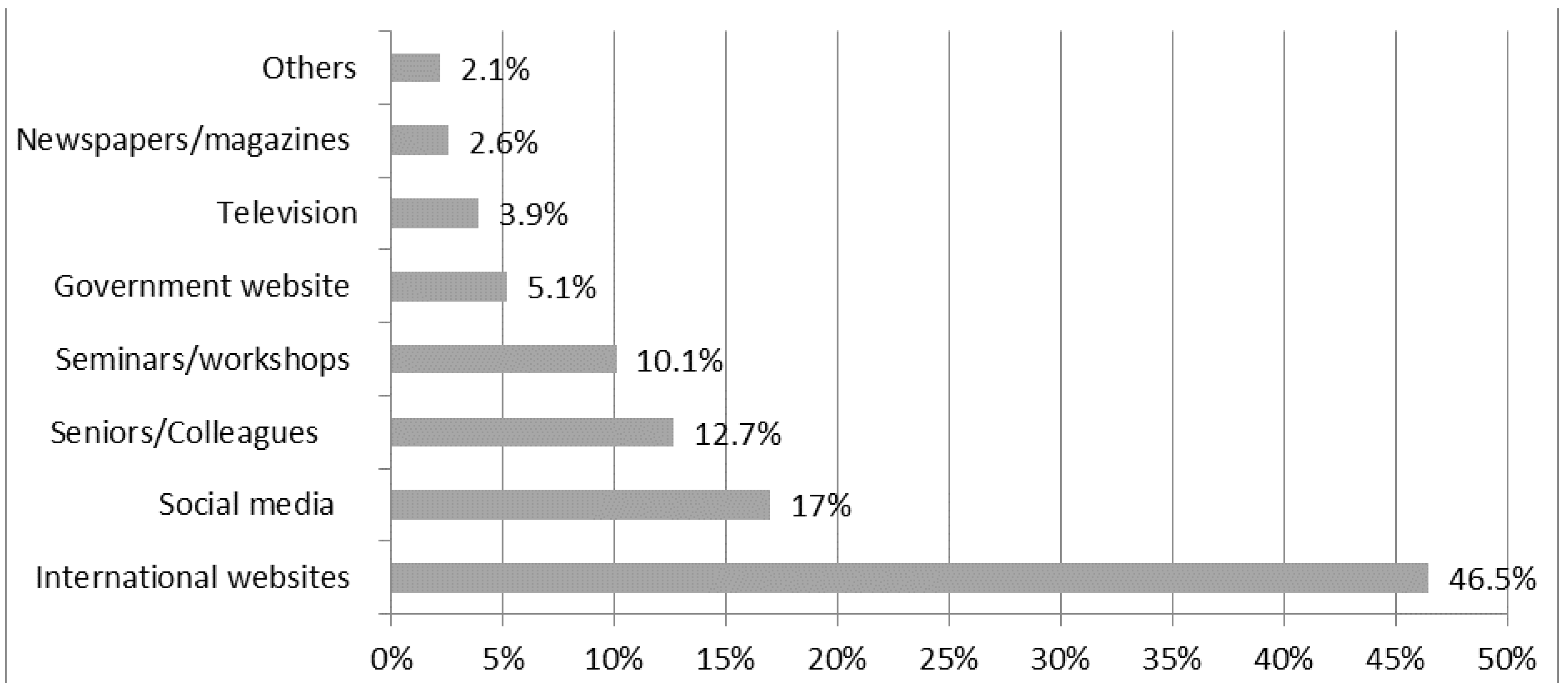
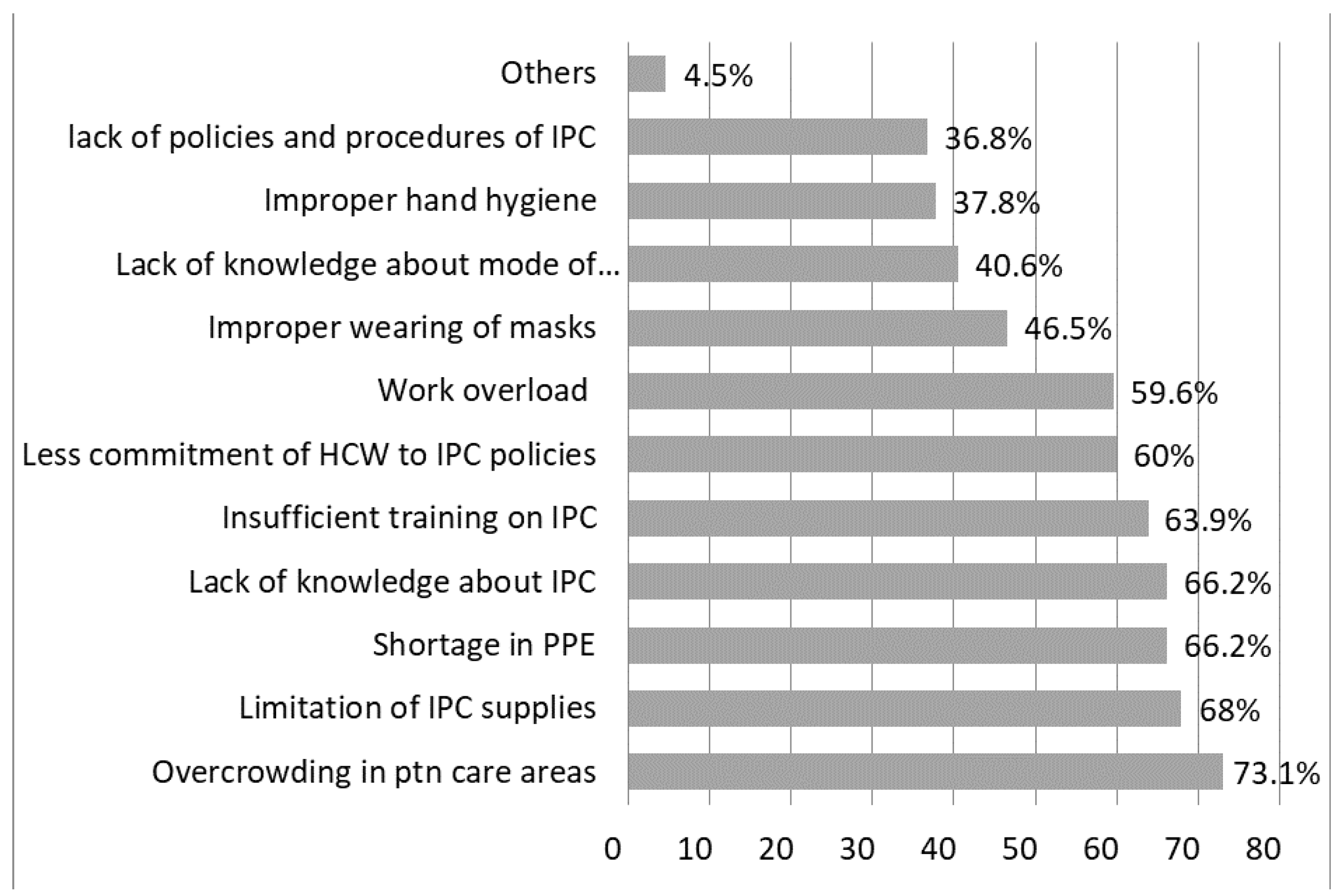
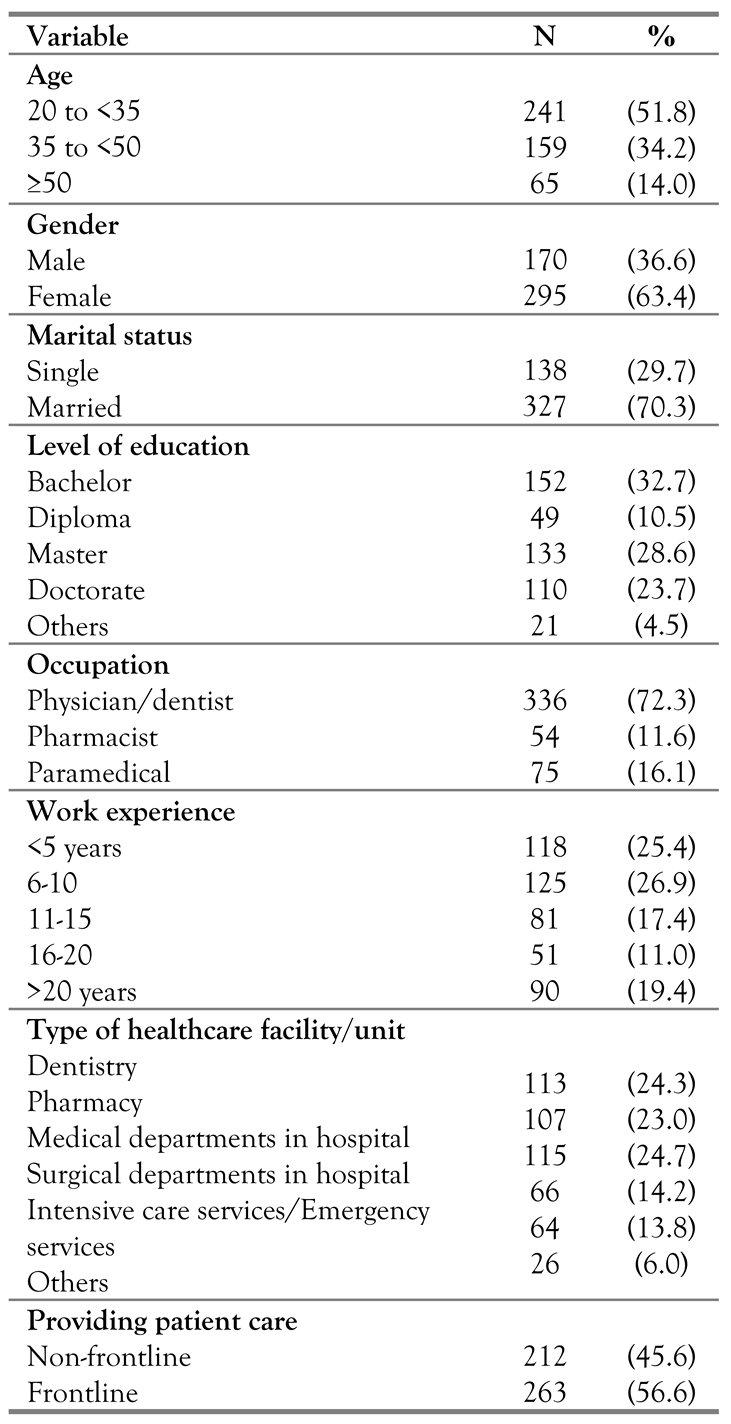
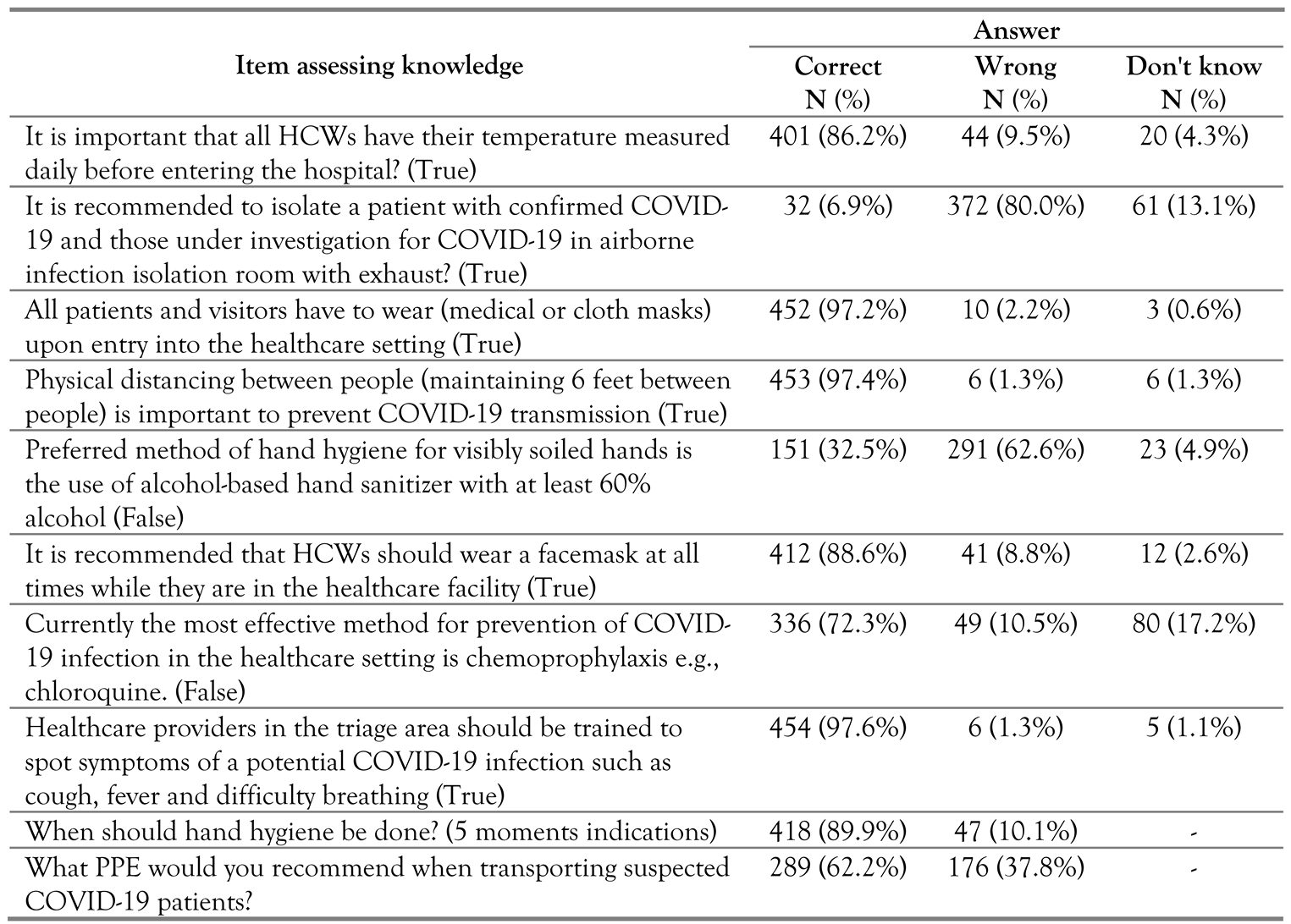
| Perception of healthcare workers | Disagree N (%) | Neutral N (%) | Agree N (%) |
|---|---|---|---|
| The health facility where I work is well equipped/prepared to manage COVID-19 infection control | 169 (36.3%) | 191 (41.1%) | 105 (22.6%) |
| I have received sufficient training in IPC specifically for COVID-19 | 202 (43.4%) | 164 (35.3%) | 99 (21.3%) |
| All healthcare professionals in my facility follow IPC measures | 148 (31.8%) | 181 (38.9%) | 136 (29.2%) |
| All healthcare providers in my facility can care for COVID-19 patients and protect themselves from infection | 183 (39.4%) | 165 (35.5%) | 117 (25.2%) |
| Supply of personal protective equipment at work is sufficient for healthcare workers | 166 (35.7%) | 152 (32.7%) | 147 (31.6%) |
| The hand hygiene supplies are sufficiently available to all personnel in the health facility where I work | 149 (32.0%) | 115 (24.7%) | 201 (43.2%) |
| Everyone at my work place has an easy access to COVID-19 infection control policies | 124 (26.7%) | 157 (33.8%) | 184 (39.6%) |
| I can easily access PPE in the healthcare facility where I work | 166 (35.7%) | 159 (34.2%) | 140 (30.1%) |
| In the health facility where I work there are a sufficient number of well- equipped isolation rooms for patients with suspected COVID-19 | 202 (43.4%) | 165 (35.5%) | 98 (21.1%) |
| The health facility where I work receives adequate support from national/regional/local public health authorities, who provide guidance and training on how to manage COVID-19 | 161 (34.6%) | 177 (38.1%) | 127 (25.8%) |
| The healthcare facility where I work provides a protocol for early detection of infected cases among healthcare providers | 178 (38.3%) | 149 (32.0%) | 138 (29.7%) |
| Item of self-confidence | Disagree N (%) | Neutral N (%) | Agree N (%) |
|---|---|---|---|
| I can correctly put on and take off personal protective equipment to | 58 (12.5%) | 129 | 278 |
| prevent transmission of COVID-19 to others and myself | (27.7%) | (59.8%) | |
| I am confident of my knowledge about COVID-19 prevention | 37 (8.0%) | 184 | 244 |
| (39.6%) | (52.5%) | ||
| I can identify reliable sources of information regarding COVID-19 | 39 (8.4%) | 142 | 284 |
| preventive practices | (30.5%) | (61.1%) | |
| I can educate others on appropriate infection prevention and control | 55 (11.8%) | 159 | 251 |
| measures | (34.2%) | (54.0%) | |
| I can protect myself and my family from COVID-19 infection | 67 (14.4%) | 202 | 196 |
| (43.4%) | (42.2%) | ||
| I can protect my patients from COVID-19 Infection | 79 (17.0%) | 216 | 170 |
| (46.5%) | (36.6%) | ||
| I am confident in getting the needed support from senior medical/nurse | 106 | 185 | 174 |
| staff to apply recommended infection prevention and control measures | (22.8%) | (39.8%) | (37.4%) |
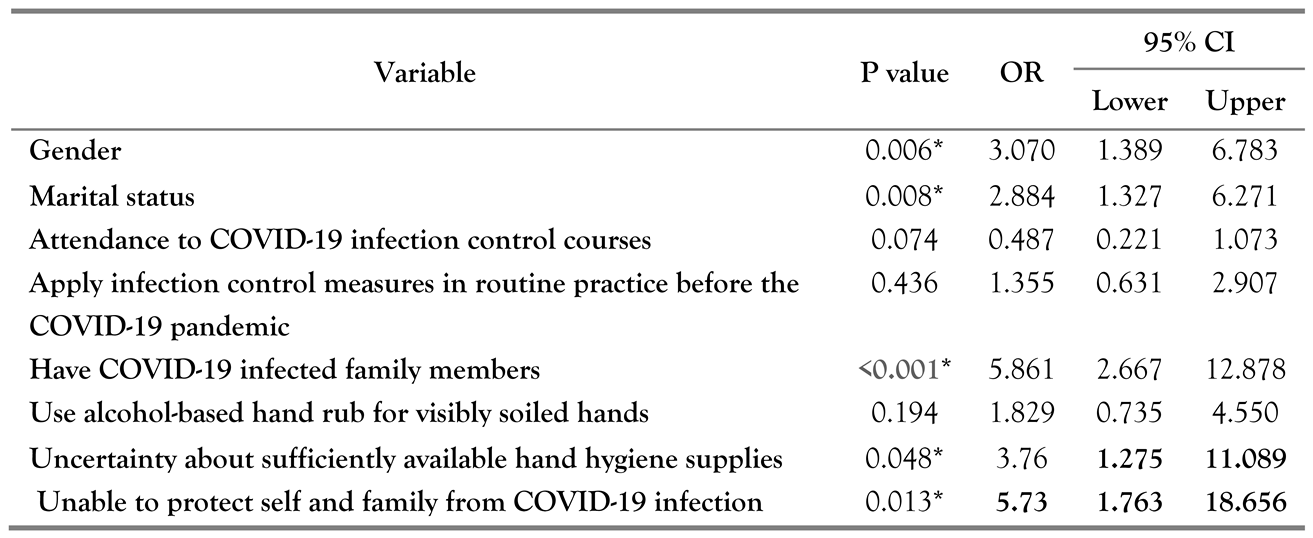
© GERMS 2021.
Share and Cite
Elgibaly, O.; Daef, E.; Elghazally, S.A.; Hassan, H.M.; ElsaidTash, R.M.; Bahgat, S.M.; Elantouny, N.G.; Zarzour, A.A.; Othman, M.M.A.; El-Sokkary, R.H. Knowledge, Perception, and Confidence of Healthcare Workers About COVID-19 Preventive Measures During the First Wave of the Pandemic: A Cross-Sectional Study from Egypt. GERMS 2021, 11, 179-188. https://doi.org/10.18683/germs.2021.1255
Elgibaly O, Daef E, Elghazally SA, Hassan HM, ElsaidTash RM, Bahgat SM, Elantouny NG, Zarzour AA, Othman MMA, El-Sokkary RH. Knowledge, Perception, and Confidence of Healthcare Workers About COVID-19 Preventive Measures During the First Wave of the Pandemic: A Cross-Sectional Study from Egypt. GERMS. 2021; 11(2):179-188. https://doi.org/10.18683/germs.2021.1255
Chicago/Turabian StyleElgibaly, Omaima, Enas Daef, Shimaa A. Elghazally, Hebatallah M. Hassan, Rehab M. ElsaidTash, Shereen M. Bahgat, Neveen G. Elantouny, Amro A. Zarzour, Marwa M. Ayesh Othman, and Rehab H. El-Sokkary. 2021. "Knowledge, Perception, and Confidence of Healthcare Workers About COVID-19 Preventive Measures During the First Wave of the Pandemic: A Cross-Sectional Study from Egypt" GERMS 11, no. 2: 179-188. https://doi.org/10.18683/germs.2021.1255
APA StyleElgibaly, O., Daef, E., Elghazally, S. A., Hassan, H. M., ElsaidTash, R. M., Bahgat, S. M., Elantouny, N. G., Zarzour, A. A., Othman, M. M. A., & El-Sokkary, R. H. (2021). Knowledge, Perception, and Confidence of Healthcare Workers About COVID-19 Preventive Measures During the First Wave of the Pandemic: A Cross-Sectional Study from Egypt. GERMS, 11(2), 179-188. https://doi.org/10.18683/germs.2021.1255




